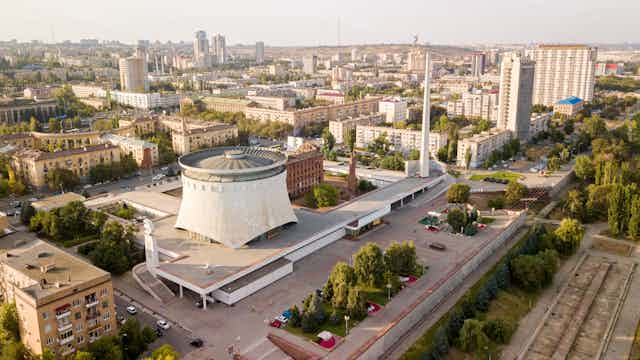In 1944, Stalingrad (as Volgograd was called until 1961) and the British city of Coventry became the first Anglo-Soviet twin cities. Volgograd has a Coventry Street and Coventry has a Volgograd Place. And, as the England team get set to play their opening World Cup match in the Russian city, it’s seems apt to reflect on an Anglo-Russian relationship that has endured into other tumultuous political times.
In April 2000, the late Queen Mother was made an honorary citizen of Volgograd in recognition of her postwar relief work for Stalingrad. In an exchange at between the mayor of Volgograd, Yuri Chekhov, and the Queen Mother, he said:
We remember well that the first hospital sent to Stalingrad at that time was from Britain, and it was you who helped to collect funds for this.
She replied:
In the war, the King and I greatly admired the wonderful fortitude of your soldiers and the people of Stalingrad.
Coventry Blitz and the Battle of Stalingrad
The industrial city of Coventry was first bombed in June 1940. On November 14, a sustained 11-hour raid by more than 500 German bombers killed 554 men, women and children and injured 865 more. The old city of Coventry was destroyed, as were 4,330 homes. In one long night, three-quarters of the factories whose production was so vital to the British war effort were damaged. In August 1942, Coventry endured the last of 41 devastating raids.

Stalingrad was also a major industrial city, strategically located on the western bank of the Volga River in south-western Russia on route to the oil fields of the Caucasus. The Battle of Stalingrad started on August 23 1942 and was marked by both bombing and artillery fire that reduced the city to rubble, and close combat, house-to-house fighting. Hitler gave the order: “No retreat”, while Stalin issued Order No. 227 to the opposing Red Army and Stalingrad’s civilians – it forbade surrender and declared: “Not a Step Back!”
By the time that the 91,000 Axis forces, led by Field Marshall Friedrich Paulus, surrendered on February 2 1943, nearly 40,000 soviet civilians had died and more than a million Soviet military personnel were killed, wounded or missing. The battle of Stalingrad was a decisive Soviet victory, it halted the Nazi advance.
The Sword of Stalingrad
In 1943 the British prime minister, Winston Churchill, and King George VI decided to recognise the sacrifice of the Russian people with the Sword of Stalingrad or the King’s Sword, which they commissioned from the Wilkinson Sword Company. The sword was engraved with the words: “To the steel-hearted citizens of Stalingrad, the gift of King George the sixth, in token of homage of the British People.”

The Russian word for steel – stal’ – is the root of both Stalin and the city named in his honour, Stalingrad. The sword toured British cities as part of the war-time propaganda campaign to promote the Anglo-Soviet alliance. In December 1943, Churchill presented the Sword of Stalingrad to Stalin at the Tehran Conference and in 1944 it was presented to the people of Stalingrad. The British craftsmen who made the sword were presented with commemorative albums at the Soviet embassy.
Tablecloth diplomacy
From late 1941 British Soviet Friendship Unity Committees and Anglo-Soviet Unity or Friendship Committees were set up in towns and cities in Britain under civic leadership. Their role was to promote the Anglo-Soviet alliance and to raise funds for food and medical supplies for the USSR.
For Coventry, the onslaught on Stalingrad had particular resonance. The women of Coventry sent a message to Stalingrad while it was still under attack:
From this city scarred and ravaged by the arch enemy of civilisation, our hearts go out to you, who now face slaughter and suffering even more fearful.
In order to fundraise and show support for Stalingrad, 830 Coventry women paid to sign their names on a tablecloth – and the names were embroidered together with the words: “Little help is better than big sympathy.”

The table cloth was sent to Stalingrad with a message of support in 1944 and is now displayed in the Panorama Museum of the Battle of Stalingrad. In 2008, to mark the 65th anniversary of the twinning, people in Volgograd made a Stalingrad tablecloth for Coventry. In 2014, Twin Song, a symphonic poem specially composed for the 70th anniversary of the Coventry-Volgograd twinning was performed at Coventry Cathedral by the Volgograd and Coventry Youth Orchestras, conducted by Yuri Ilynov.
In a bid to later promote peace and reconciliation Coventry also twinned with former enemy German cities including Kiel in 1947 and Dresden in 1956.
Is town twinning still relevant?
Cost is given as one reason to end twinning, and in 2009, Doncaster in South Yorkshire ended all its twinning agreements, saving £4,000. But while twinning has been condemned as junkets for a few councillors, most cities now seek economic benefits from twinning such as closer business ties.
In 2012, when St Petersburg introduced legislation against “homosexual propaganda”, there were also for calls for its sister cities to end twinning arrangements. Milan, which had a friendship (it wasn’t formally twinned with St Petersburg), ended its connection. Other twin cities such as Manchester, while condemning the legislation, argued that it was important to keep communication open.
The Coventry-Volgograd relationship was born out of a wartime alliance and shared suffering. Throughout the ups and downs of the ensuing intergovernmental relationship, this civic level link has strongly endured.

